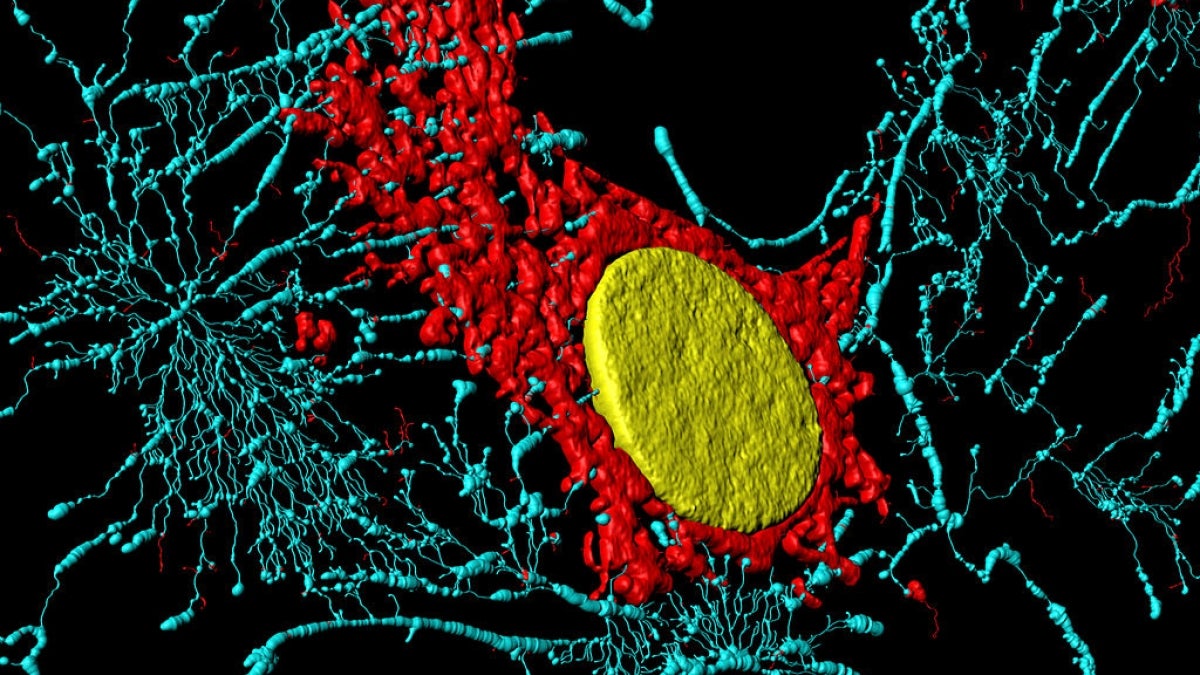Evolving a new way of looking at cell classification

"Fibroblast (BPAE)" by Heiti Paves. Licensed under CC BY-SA 3.0 via Wikimedia Commons
Cells have traditionally been categorized based on location within an organism, their structure, function or even developmental history. But recent advances suggest there might be better and more uniform approaches to cell classification and understanding.
Researchers at the Arizona State University-Santa Fe Institute Center for Biosocial Complex Systems recently convened a workshop to sort out some of the details of a new classification system for cells. Their work was recently reported on in Science magazine.
“Ultimately what determines the function of each cell or each cell type are the genes that are turned on in that cell,” said Manfred Laubichler, an ASU President’s Professor of theoretical biology and the history of biology. Laubichler also is co-director of the ASU-SFI Center for Biosocial Complex Systems.
A better theory of gene regulation within cells is needed in order to understand how cell types have evolved and how they might change in the future, he said.
“The emergence of a new cell type represents an evolutionary innovation,” he explained. “This makes it all the more important to clearly redefine what a cell type is.”
As they made progress in their individual fields and addressed similar questions, experts in cell biology, evolutionary biology and systems biology developed different concepts and terminology in their work. Unifying these definitions and approaches could lead to a more robust theory of cell evolution. Jump-starting this effort was a goal of the workshop.
Laubichler and colleagues Günter Wagner (Yale University) and Detlev Arendt (European Molecular Biological Laboratory) organized the working group, which was hosted by SFI. It brought together experts in these fields to develop a more unified understanding of cell type evolution.
The group is now working on a perspectives paper summarizing their deliberations that will be the foundation of a more focused research effort to tackle the problem of cell type diversity and evolution.
“Another reason why we need to focus on these questions now is the increased prominence of cellular reprogramming and regenerative medicine,” said Laubichler, who is also a member of ASU’s Center for Evolution and Medicine. “Without evolutionary perspectives these efforts are prone to miss important constraints and future directions. This way, the theoretical work we are pursuing at the SFI connects to ASU’s new focus on evolutionary medicine.”
Innovation was the focus of a second workshop, also held at SFI and organized by the ASU-SFI Center for Biosocial Complexity. The goal of this group, according to Laubichler, was to explore how to transform innovation — thought of as a search process sorting through endless combinatorial possibilities — into formal, even predictive models.
The workshop built on an earlier ASU-SFI effort that explored the drivers of invention and the challenges of building a theory of innovation.
“With universal problems, such as innovation, we need a broad interdisciplinary discussion to grasp the fundamental nature of the problem so that we can arrive at deep theoretical insights,” said Laubichler, who co-organized the meeting with ASU collaborator Jose Lobo. “And we need those insights to have real-world impacts.”
A few participants have taken steps, using data on patented inventions or cell metabolic pathways to build empirical search spaces. The goal is a general framework for innovation that could arise from similarities the participants and others observe in their separate search spaces.
Lobo pointed to Darwin’s Theory of Evolution as a possible framework.
If we can begin to build a similarly general theory of innovation, he said, “it will help us explain how things emerge and thrive.”
Some think the very nature of innovation obviates prediction. Still, certain features of companies and societies make them more inventive and innovative than others, Lobo explained. Whether such a theory is possible will be much discussed, but “all agree, in the absence of a good theory we won’t be able to make predictions.”
These workshops come right after ASU, in partnership with the SFI and the Complex Systems Society, hosted a large international conference on complex systems science.
“The ASU-SFI collaboration is off to a great start, building on long-term close connections,” said Laubichler, who with ASU professors Rob Boyd, Carlos Castillo-Chavez, Rob Page and Sander van der Leuuw, is an external professor at the Santa Fe Institute.
More Science and technology

Will this antibiotic work? ASU scientists develop rapid bacterial tests
Bacteria multiply at an astonishing rate, sometimes doubling in number in under four minutes. Imagine a doctor faced with a…

ASU researcher part of team discovering ways to fight drug-resistant bacteria
A new study published in the Science Advances journal featuring Arizona State University researchers has found…

ASU student researchers get early, hands-on experience in engineering research
Using computer science to aid endangered species reintroduction, enhance software engineering education and improve semiconductor…